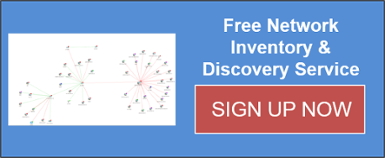-
Call Us:1.800.561.4019
Newsletter
For a Free Quote...
Latest Blog Posts
Blog Categories
Telnet Networks News
3 Steps to Configure Your Network For Optimal Discovery
 All good network monitoring / management begins the same way – with an accurate inventory of the devices you wish to monitor. These systems must be on boarded into the monitoring platform so that it can do its job of collecting KPI’s, backing up configurations and so on. This onboarding process is almost always initiated through a discovery process.
All good network monitoring / management begins the same way – with an accurate inventory of the devices you wish to monitor. These systems must be on boarded into the monitoring platform so that it can do its job of collecting KPI’s, backing up configurations and so on. This onboarding process is almost always initiated through a discovery process.
This discovery is carried out by the monitoring system and is targeted at the devices on the network. The method of targeting may vary, from a simple list of IP addresses or host names, to a full subnet discovery sweep, or even by using an exported csv file from another system. However, the primary means of discovery is usually the same for all Network devices, SNMP.
Additional means of onboarding can (and certainly do) exist, but I have yet to see any full-featured management system that does not use SNMP as one of its primary foundations.
SNMP has been around for a long time, and is well understood and (mostly) well implemented in all major networking vendors’ products. Unfortunately, I can tell you from years of experience that many networks are not optimally configured to make use of SNMP and other important configuration options which when setup correctly will optimize the network for a more efficient and ultimately more successful discovery and onboarding process.
Having said that, below are 3 simple steps that should be taken, in order to help maximize your network for optimal discovery.
1) Enable SNMP
Yes it seems obvious to say that if SNMP isn’t enabled then it will not work. But, as mentioned before it still astonishes me how many organizations I work with that still do not have SNMP enabled on all of the devices they should have. These days almost any device that can connect to a network usually has some SNMP support built in. Most networks have SNMP enabled on the “core” devices like Routers / Switches / Servers, but many IT pros many not realize that SNMP is available on non- core systems as well.
Devices like VoIP phones and video conferencing systems, IP connected security cameras, Point of Sale terminals and even mobile devices (via apps) can support SNMP. By enabling SNMP on as many possible systems in the network, the ability to extend the reach of discovery and monitoring has grown incredibly and now gives visibility into the network end-points like never before.
2) Setup SNMP correctly
Just enabling SNMP isn’t enough – the next step is to make sure it is configured correctly. That means removing / changing the default Read Only (RO) community string (which is commonly set by default to “public”) to a more secure string. It is also best practice to use as few community strings as you can. In many large organizations, there can be some “turf wars” over who gets to set these strings on systems. The Server team may have one standard string and the network team has another.
Even though most systems will allow for multiple strings, it is generally best to try to keep these as consistent as possible. This helps prevent confusion when setting up new systems and also helps eliminate unnecessary discovery overhead on the management systems (which may have to try multiple community strings for each device on an initial discovery run). As always, security is important, so you should configure the IP address of the known management server as an allowed SNMP system and block any other systems from being allowed to run an SNMP query against your systems.
3) Enable Layer 2 discovery protocols
In your network, you want much deeper insight into not only what you have, but how it is all connected. One of the best way to get this information is to enable layer 2 (link layer) discovery abilities. Depending on the vendor(s) you have in your network, this may accomplished with a proprietary protocol like the Cisco Discovery Protocol (CDP) or it may be implemented in a generic standard like the Link Layer Discovery Protocol (LLDP). In either case, by enabling these protocols, you gain valuable L2 connectivity information like connected MAC addresses, VLAN’s, and more.
By following a few simple steps, you can dramatically improve the results of your management system’s onboarding / discovery process and therefore gain deeper and more actionable information about your network.
Thanks to NMSaaS for the article.
When you subscribe to the blog, we will send you an e-mail when there are new updates on the site so you wouldn't miss them.






Comments